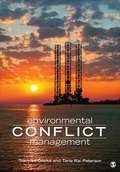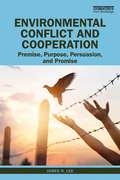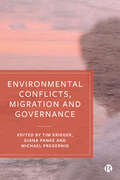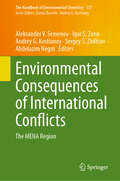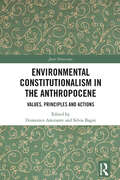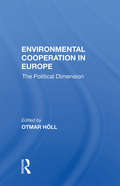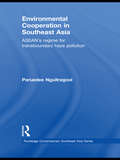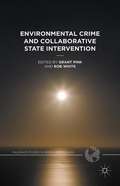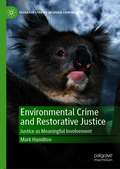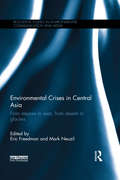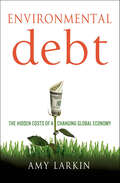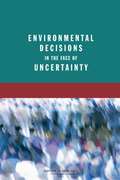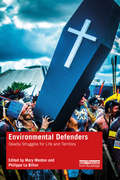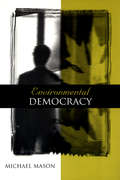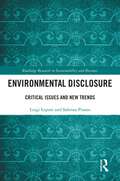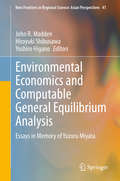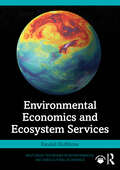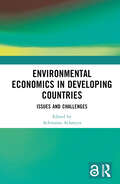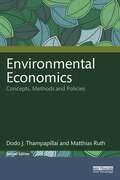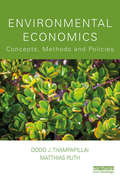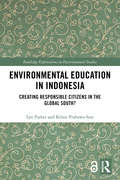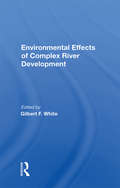- Table View
- List View
Environmental Conflict Management
by Tarla Rai Peterson Tracy Lee ClarkeA step-by-step guide connecting theory to practice Environmental Conflict Management introduces students to the research and practice of environmental conflict and provides a step-by-step process for engaging stakeholders and other interested parties in the management of environmental disputes. In each chapter, authors Dr. Tracylee Clarke and Dr. Tarla Rai Peterson first introduce a specific concept or process step and then provide exercises, worksheets, role-plays, and brief case studies so students can directly apply what they are learning. The appendix includes six additional extended case studies for further analysis. In addition to providing practical steps for understanding and managing conflict, the text identifies the most relevant laws and policies to help students make more informed decisions. Students will develop techniques for public involvement and community outreach, strategies for effective meeting management, approaches to negotiating options and methodologies for communicating concerns and working through differences, and outlines for implementing and evaluating strategies for sustaining positive community relations.
Environmental Conflict Management
by Tarla Rai Peterson Tracy Lee ClarkeA step-by-step guide connecting theory to practice Environmental Conflict Management introduces students to the research and practice of environmental conflict and provides a step-by-step process for engaging stakeholders and other interested parties in the management of environmental disputes. In each chapter, authors Dr. Tracylee Clarke and Dr. Tarla Rai Peterson first introduce a specific concept or process step and then provide exercises, worksheets, role-plays, and brief case studies so students can directly apply what they are learning. The appendix includes six additional extended case studies for further analysis. In addition to providing practical steps for understanding and managing conflict, the text identifies the most relevant laws and policies to help students make more informed decisions. Students will develop techniques for public involvement and community outreach, strategies for effective meeting management, approaches to negotiating options and methodologies for communicating concerns and working through differences, and outlines for implementing and evaluating strategies for sustaining positive community relations.
Environmental Conflict and Cooperation: Premise, Purpose, Persuasion, and Promise
by James R. LeeEnvironmental Conflict and Cooperation explores the evolution of environmental conflict as a field of research and the study of cooperation as an alternative to war. Over four key parts, James R. Lee navigates the contours of this growing field and paints a vivid framework for better understanding issues around environmental conflict and security: • The premise of the field and its historic manifestations • The definition and purpose of research • The persuasions or types of environmental conflict and cooperation • The promise of research in leading to better decision-making and to broaching new challenges. Over the course of these parts, the author outlines the deep historic record of this discipline, arguing that it will play a key role in understanding important future trends. Utilizing a wide variety of case studies that range from ancient examples, including conflict over the Cedars of Lebanon and the role of tin in the Peloponnesian Wars, to future-oriented scenarios, including expanded island-building in the South China Sea and the global politics of geo-engineering, Lee highlights key concepts, metrics, and policy contexts that will test current understandings. He also examines a variety of research methods and provides examples of the ways in which such research can be used to inform policy improvements. This book will draw specific interest from students and scholars of environmental conflict and cooperation, as well as researchers of environmental politics and security studies.
Environmental Conflicts, Migration and Governance
by Tim Krieger, Diana Panke and Michael PregernigThe globalized era is characterized by a high degree of interconnectedness across borders and continents and this includes human migration. Migration flows have led to new governance challenges and, at times, populist political backlashes. A key driver of migration is environmental conflict and this is only likely to increase with the effects of climate change. Bringing together world-leading researchers from across political science, environmental studies, economics and sociology, this urgent book uses a multifaceted theoretical and methodological approach to delve into core questions and concerns surrounding migration, climate change and conflict, providing invaluable insights into one of the most pressing global issues of our time.
Environmental Consequences of International Conflicts: The MENA Region (The Handbook of Environmental Chemistry #137)
by Andrey G. Kostianoy Igor S. Zonn Sergey S. Zhiltsov Aleksander V. Semenov Abdelazim NegmThis is the first of two volumes that, taken together, provide an integrated picture of the environmental consequences arising from international conflicts. The volumes build upon the successful book Environmental Consequences of War and Aftermath published in The Handbook of Environmental Chemistry in 2009. The books focus on environmental consequences only and discuss land degradation, erosion, water scarcity and pollution, water resources management, air pollution, desertification, deforestation, food scarcity and radioactive contamination, among others. This volume addresses conflicts in the MENA region (Middle East and North Africa), covering historical and more recent events such as water conflicts, military conflicts, migration and overpopulation, and infrastructure projects. Readers will also find several chapters in this book on the theory of international conflicts and their impact on the environment in general. Given its breadth, this book appeals to environmental scientists, policy makers, and researchers interested in the environmental impacts of international conflicts.
Environmental Constitutionalism in the Anthropocene: Values, Principles and Actions (Juris Diversitas)
by Domenico Amirante Silvia BagniThis book examines the relationship between man and nature through different cultural approaches to encourage new environmental legislation as a means of fostering acceptance at a local level. In 2019, the International Union of Geological Sciences (IUGS) recognised that we have entered a new era, the Anthropocene, specifically characterised by the impact of one species, mankind, on environmental change. The Anthropocene is penetrating the discourse of both hard sciences and humanities and social sciences, by posing new epistemological as well as practical challenges to many disciplines. Legal sciences have so far been at the margins of this intellectual renewal, with few contributions on the central role that the notion of Anthropocene could play in forging a more effective and just environmental law. By applying a multidisciplinary approach and adopting a Law as Culture paradigm to the study of law, this book explores new paths of investigation and possible solutions to be applied. New perspectives for the constitutional framing of environmental policies, rights, and alternative methods for bottom-up participatory law-making and conflict resolution are investigated, showing that environmental justice is not just an option, but an objective within reach. The book will be essential reading for students, academics, and policymakers in the areas of law, environmental studies and anthropology.
Environmental Cooperation In Europe: The Political Dimension
by Otmar HöllThis book aims to take stock of the state of environmental degradation in Europe from theoretical and empirical point of views. It focuses on international organizations and institutions in Europe that deal with ecological problems and integrates case studies on regional environmental cooperation.
Environmental Cooperation in Southeast Asia: ASEAN's Regime for Trans-boundary Haze Pollution (Routledge Contemporary Southeast Asia Series)
by Paruedee NguitragoolOne of the most challenging environmental threats to the ten countries of the Association of Southeast Asian Nations (ASEAN) has been the haze, the sickening and deadly cloud of smoky pollution caused by widespread burning of land and forests in Indonesia. This book examines both the threat and response to it by analysing environmental cooperation in Southeast Asia from an international regime perspective. Tracing the development of regional cooperation on the haze and evaluating the effectiveness of the cooperation, the author argues that the haze crisis, combined with the economic crisis of 1997, has profoundly challenged the ASEAN modus operandi, and resulted in ASEAN’s efforts to establish an environmental regime to cope with environmental challenges. The emerging ASEAN haze regime is a unique case study of a regional environmental institution in multi-levelled global environmental governance. Based on in-depth original research, this case study is integrated into international relations, political science, and comparative political analysis literatures and contributes to a better understanding of processes within the regional organisation.
Environmental Crime and Collaborative State Intervention (Palgrave Studies In Green Criminology Ser.)
by Rob White Grant PinkThis book examines the role and practical dynamics of governmental environmental law enforcement agencies and individuals who combat environmental crime. It will inform researchers about the 'real world' experiences of practitioners and provide an intellectual space for practitioners to examine critically what it is they do and why.
Environmental Crime and Restorative Justice: Justice as Meaningful Involvement (Palgrave Studies in Green Criminology)
by Mark HamiltonThis book explores the use of restorative justice approaches in the context of environmental crimes. It critically assesses regular criminal justice approaches with regard to green crimes and explores restorative justice conferencing as an alternative. Focussing on justice approaches in Australia and New Zealand, it argues that court processes following environmental offending provide minimal to no offender and victim voice, interaction, and input, rendering them invisible. It proposes a third measure of justice – that of meaningful involvement, beyond that of fair procedure and outcome. It suggests the use of restorative justice conferencing, a facilitated dialogue between stakeholders to crime or conflict, as a vehicle to operationalise and achieve justice as meaningful involvement. This book speaks to those interested in green criminology, victimology and environmental law.
Environmental Crime in the United States: Law and Enforcement
by Karen ClarkEnvironmental Crime in the United States provides an introduction to the laws that govern environmental crime, how these laws are implemented and enforced, and the impact they have had since their passing in the twentieth century and their continued applications.Environmental crimes such as wildlife trafficking, over‑fishing, artisanal mining, and deforestation are lucrative contributors to a global illicit trade market and sources of cheap resources for corporations to exploit. This book presents a review of U.S.‑based laws and regulations regarding such environmental crimes at the state and federal level, combined with examples of international convention or trade agreements which can be prosecuted within the United States. It examines attempts to modify these laws, the exceptions granted to prevent enforcement, and the ability of political and social groups to address inefficiencies of the laws or their implementations. Both criminal and administrative laws are reviewed to assess how laws governing the environment compare to other areas of law that seek to protect and improve social well‑being and public health; this includes a review of how environmental crimes overlap with general crimes, and how these crimes fuel illicit commerce while strengthening international crime syndicates. Trends such as the actions taken by non‑governmental organizations and other entities other than law enforcement to stop environmental crimes such as poaching will be explained, with a discussion of how environmental crimes spurn illicit markets and provide lucrative schemes for international crime rings as well as corporations.This book will be of great interest to students of environmental crime and justice, green criminology, environmental conservation, natural resource management, and environmental law.
Environmental Crises in Central Asia: From steppes to seas, from deserts to glaciers (Routledge Studies in Environmental Communication and Media)
by Eric Freedman Mark NeuzilEnvironmental conditions do not exist in a vacuum. They are influenced by science, politics, history, public policy, culture, economics, public attitudes, and competing priorities, as well as past human decisions. In the case of Central Asia, such Soviet-era decisions include irrigation systems and physical infrastructure that are now crumbling, mine tailings that leach pollutants into soil and groundwater, and abandoned factories that are physically decrepit and contaminated with toxic chemicals. Environmental Crises in Central Asia highlights major environmental challenges confronting the region’s former Soviet republics: Kazakhstan, Kyrgyzstan, Tajikistan, Turkmenistan, and Uzbekistan. They include threats to the Caspian and Aral seas, the impact of climate change on glaciers, desertification, deforestation, destruction of habitat and biodiversity, radioactive and hazardous wastes, water quality and supply, energy exploration and development, pesticides and food security, and environmental health. The ramifications of these challenges cross national borders and may affect economic, political, and cultural relationships on a vast geographic scale. At the same time, the region’s five governments have demonstrated little resolve to address these complex challenges. This book is a valuable multi-disciplinary resource for academics, scholars, and policymakers in environmental sciences, geography, political science, natural resources, mass communications, public health, and economics.
Environmental Debt: The Hidden Costs of a Changing Global Economy
by Amy LarkinAn award-winning environmental activist and social entrepreneur exposes the link between our financial and environmental crisesFor decades, politicians and business leaders alike told the American public that today's challenge was growing the economy, and that environmental protection could be left to future generations. Now in the wake of billions of dollars in costs associated with coastal devastation from Hurricane Sandy, rampant wildfires across the West, and groundwater contamination from reckless drilling, it's becoming increasingly clear that yesterday's carefree attitude about the environment has morphed into a fiscal crisis of epic proportions. Amy Larkin has been at the forefront of the fight for the environment for years, and in Environmental Debt she argues that the costs of global warming, extreme weather, pollution and other forms of "environmental debt" are wreaking havoc on the economy. Synthesizing complex ideas, she pulls back the curtain on some of the biggest cultural touchstones of the environmental debate, revealing how, for instance, despite coal's relative fame as a "cheap" energy source, ordinary Americans pay $350 billion a year for coal's damage in business related expenses, polluted watersheds, and in healthcare costs. And the problem stretches far beyond our borders: deforestation from twenty years ago in Thailand caused catastrophic flooding in 2011, and cost Toyota 3.4 percent of its annual production while causing tens of thousands of workers to lose jobs in three different countries. To combat these trends, Larkin proposes a new framework for 21st century commerce, based on three principles: 1) Pollution can no longer be free; 2) All business decision making and accounting must incorporate the long view; and 3) Government must play a vital role in catalyzing clean technology and growth while preventing environmental destruction. As companies and nations struggle to strategize in the face of global financial debt, many businesses have begun to recognize the causal relationship between a degraded environment and a degraded bottom line. Profiling the multinational corporations that are transforming their operations with downright radical initiatives, Larkin presents smart policy choices that would actually unleash these business solutions to many global financial and environmental problems. Provocative and hard-hitting, Environmental Debt sweeps aside the false choices of today's environmental debate, and shows how to revitalize the economy through nature's bounty.
Environmental Decision-Making in Context: A Toolbox (ASPA Series in Public Administration and Public Policy)
by Chad J. McGuireBecause of the complexity involved in understanding the environment, the choices made about environmental issues are often incomplete. In a perfect world, those who make environmental decisions would be armed with a foundation about the broad range of issues at stake when making such decisions. Offering a simple but comprehensive understanding of the critical roles science, economics, and values play in making informed environmental decisions, Environmental Decision-Making in Context: A Toolbox provides that foundation. The author highlights a primary set of intellectual tools from different disciplines and places them into an environmental context through the use of case study examples. The case studies are designed to stimulate the analytical reasoning required to employ environmental decision-making and ultimately, help in establishing a framework for pursuing and solving environmental questions, issues, and problems. They create a framework individuals from various backgrounds can use to both identify and analyze environmental issues in the context of everyday environmental problems. The book strikes a balance between being a tightly bound academic text and a loosely defined set of principles. It takes you beyond the traditional pillars of academic discipline to supply an understanding of the fundamental aspects of what is actually involved in making environmental decisions and building a set of skills for making those decisions.
Environmental Decisions in the Face of Uncertainty
by Institute of Medicine Committee on Decision Making Under Uncertainty Board on Population Health and Public Health PracticeThe U.S. Environmental Protection Agency (EPA) is one of several federal agencies responsible for protecting Americans against significant risks to human health and the environment. As part of that mission, EPA estimates the nature, magnitude, and likelihood of risks to human health and the environment; identifies the potential regulatory actions that will mitigate those risks and protect public health1 and the environment; and uses that information to decide on appropriate regulatory action. Uncertainties, both qualitative and quantitative, in the data and analyses on which these decisions are based enter into the process at each step. As a result, the informed identification and use of the uncertainties inherent in the process is an essential feature of environmental decision making. EPA requested that the Institute of Medicine (IOM) convene a committee to provide guidance to its decision makers and their partners in states and localities on approaches to managing risk in different contexts when uncertainty is present. It also sought guidance on how information on uncertainty should be presented to help risk managers make sound decisions and to increase transparency in its communications with the public about those decisions. Given that its charge is not limited to human health risk assessment and includes broad questions about managing risks and decision making, in this report the committee examines the analysis of uncertainty in those other areas in addition to human health risks. Environmental Decisions in the Face of Uncertainty explains the statement of task and summarizes the findings of the committee.
Environmental Defenders: Deadly Struggles for Life and Territory (Routledge Explorations in Environmental Studies)
by Mary Menton; Philippe Le BillonThis book is about environmental defenders and the violence they face while seeking to protect their land and the environment. Between 2002 and 2019, at least two thousand people were killed in 57 countries for defending their lands and the environment. Recent policy initiatives and media coverage have provided much needed attention to the protection and support of defenders, but there has so far been little scholarly work. This edited volume explains who these defenders are, what threats they face, and what can be done to help support and protect them. Delving deep into the complex relations between and within communities, corporations, and government authorities, the book highlights the diversity of defenders, the collective character of their struggles, the many drivers and forms of violence they are facing, as well as the importance of emotions and gendered dimensions in protests and repression. Drawing on global case studies, it examines the violence taking place around different types of development projects, including fossil fuels, agro-industrial, renewable energy, and infrastructure. The volume also examines the violence surrounding conservation projects, including through militarized wildlife protection and surveillance technologies. The book concludes with a reflection on the perspectives of defenders about the best ways to support and protect them. It contrasts these with the lagging efforts of an international community often promoting economic growth over the lives of defenders. This volume is essential reading for all interested in understanding the challenges faced by environmental defenders and how to help and support them. It will also appeal to students, scholars and practitioners involved in environmental protection, environmental activism, human rights, social movements and development studies.
Environmental Democracy: A Contextual Approach
by Michael MasonThrough a wide range of case studies, Mason reveals just how sensitive we all must be to styles of power, vulnerability and resilience in any democratic transition to sustainability. This is a fine book.' Timothy O'Riordan, Professor of Environmental Science, University of East Anglia, and Associate Director, Centre for Social and Economic Research on the Global Environment. Civic self-determination and ecological sustainability are widely accepted as two of the most important public goals. This book explains how they can be combined. Using vivid and telling case studies from around the world, it shows how liberal rights can include both ecological and social conditions for collective decision-making - environmentalist goals and social justice can be achieved together. Integrating theory and original case studies, the book makes a very significant contribution to the fundamentals of how environmental democracy can be advanced at all levels. Cogently argued and engaged, Environmental Democracy provides a superb teaching text and a source of ideas and persuasive arguments for the politically and environmentally engaged. It will be essential reading for students, teachers and researchers in politics, policy studies, environmental studies, geography and social science.
Environmental Disclosure: Critical Issues and New Trends (Routledge Research in Sustainability and Business)
by Luigi Lepore Sabrina PisanoThis book provides a description of the state of the art on environmental disclosure, illustrating the key theoretical issues, the regulatory frameworks, the main standards developed and reporting the results of an empirical analysis on the environmental disclosure released by listed firms. Luigi Lepore and Sabrina Pisano begin by analysing the origin and evolution of environmental disclosure. They go on to provide a description of the main theoretical frameworks used by scholars, explaining the conceptual basis of each theory and describing how the specific theory has been used to explain the company’s decision to release environmental disclosure. The second part of the book highlights the role and evolution of the European regulatory frameworks, emphasizing the transition from voluntary to mandatory disclosure. The book ends by providing a picture of the evolution of sustainability reporting practices in European Union nations over the past two decades. This book investigates the critical issues and new directions in environmental disclosure, which are currently under examination by regulators and standard setters. It will therefore be of great interest to academics and students working in the areas of business and sustainability.
Environmental Economics and Computable General Equilibrium Analysis: Essays in Memory of Yuzuru Miyata (New Frontiers in Regional Science: Asian Perspectives #41)
by John Madden Hiroyuki Shibusawa Yoshiro HiganoThis book addresses major issues such as a growing world energy demand, environmental degradation due to anthropogenic greenhouse gas (GHG) emission, and risk management of disastrous events such as pandemics, abnormal climate, and earthquakes. Using cutting-edge analytical tools, particularly computable general equilibrium (CGE) modelling, the analyses are focused on a very wide range of policy-relevant economic questions for the Asia-Pacific region, especially for Japan, China, India, Vietnam, and smaller nations, including Brunei, Timor Leste, and Fiji. The first part considers (a) the effects of climate change on agriculture sectors, energy policies, and future GHG emission trends, (b) adaptation to climate changes in energy policy and its impacts on the economies, and (c) risk management of catastrophic events such as global pandemics. The second part examines (a) energy environmental issues, (b) economic impacts of natural disaster and depopulation, and (c) effects of informatics development on risk management, using CGE modelling and other methods in regional science fields. Contributors are internationally active leading CGE modellers and environmental economists. The book should be greatly beneficial for scholars and graduate students as well as policy makers who are interested in the economic effects and management of risks relating to climate change and disastrous events.
Environmental Economics and Ecosystem Services (Routledge Textbooks in Environmental and Agricultural Economics)
by Randall BluffstoneEnvironmental Economics and Ecosystem Services provides a rigorous yet accessible introduction to environmental economics, using ecosystem services as the underlying framework. Assuming no prior knowledge of economics, and using a conversational writing style, the focus is on exploring society’s linkages with the environment and how economics can help solve key environmental problems.Structured in three parts, the book first introduces readers to the key theories in environmental economics and ecosystem services, and then explores the challenges of conservation. The final section examines environmental policy options, such as cap-and-trade, behavioral nudges, community-based natural resource management and carbon taxes. There is a strong international focus throughout the book, with real-life examples taken from North America, Europe, Asia, Africa and other regions. Students are supported by a range of pedagogical features, including chapter objectives, chapter summaries, discussion questions and further reading suggestions. In addition, the book offers worked examples, analytical problems and “Challenge Yourself” boxes to develop critical thinking skills. Lecture slides and answers to questions for discussion and practice problems are available for instructors.This is the ideal text for introductory courses in environmental economics, ecological economics, economics of sustainability, environmental management, environmental policy and ecosystem services.
Environmental Economics in Developing Countries: Issues and Challenges
by Achiransu AcharyyaThe COVID-19 pandemic has laid bare the vulnerabilities of socio-economic systems globally and exposed the risks that natural capital degradation imposes on human health, economy, and society. This book studies the environmental challenges faced by developing economies in a post-COVID-19 world. Exploring diverse case studies from South Asia and Sub-Saharan Africa, the volume discusses the impact that economic development and, recently, COVID-19 has had on the environment, ecology, and economy of these regions. It analyses nature conservation policies aimed at minimizing ecological damage arising from economic development and discusses the policy objectives of sustainable development. It also highlights the significant role that environmental economics networks have played in capacity building, framing of policies using ecological economics tools, and developing a local leadership trained in addressing local sustainability issues. An important contribution to the study of environmental economics of the Global South, the book will be of interest to students and researchers of economics, environment, development studies, development economics, environmental policies, and South Asia studies. It will also be useful for policymakers and NGOs working in this field.
Environmental Economics: Concepts, Methods and Policies
by Matthias Ruth Dodo J. ThampapillaiEnvironmental Economics explores the ways in which economic theory and its applications, as practised and taught today, must be modified to explicitly accommodate the goal of sustainability and the vital role played by environmental capital.Pivoting around the first and second laws of thermodynamics, as well as the principles of ecological resilience, this book is divided into five key parts, which include extensive coverage of environmental microeconomics and macroeconomics. It drills down into issues and challenges including consumer demand; production and supply; market organisation; renewable and non-renewable resources; environmental valuation; macroeconomic stabilisation and international trade and globalisation. Drawing on case studies from forestry, water, soil, air quality and mining, this book will equip readers with skills that enable the analyses of environmental and economic policy issues with a specific focus on the sustainability of the economy. This new edition has been updated throughout and provides further coverage on topics such as energy transition, market organisation and the role of environmental economics in regulatory decision-making including critiques of contemporary policy directives like tradable pollution permits and net zero emissions. Challenges to achieving stabilisation and emission reduction have been expanded to include wars and conflicts such as those in the Middle East and the Russian invasion of Ukraine. This book further reinforces the premise that there are clear limits to growth and that modesty and moderation are superior alternatives.Rich in pedagogical features, including key concept boxes and review questions at the end of each chapter, this book will be a vital resource for upper-level undergraduate and postgraduate students studying not only environmental economics/ecological economics but also economics in general.
Environmental Economics: Concepts, Methods and Policies (New Horizons In Environmental Economics Ser.)
by Matthias Ruth Dodo J. ThampapillaiEnvironmental Economics explores the ways in which economic theory and its applications, as practised and taught today, must be modified to explicitly accommodate the goal of sustainability and the vital role played by environmental capital. Pivoting around the first and second laws of thermodynamics, as well as the principles of ecological resilience, this book is divided into five key parts, which includes extensive coverage of environmental microeconomics and macroeconomics. It drills down into issues and challenges including consumer demand; production and supply; market organisation; renewable and non-renewable resources; environmental valuation; macroeconomic stabilisation, and international trade and globalisation. Drawing on case studies from forestry, water, soil, air quality, and mining, this book will equip readers with skills that enable the analyses of environmental and economic policy issues with a specific focus on the sustainability of the economy. Rich in pedagogical features, including key concepts boxes and review questions at the end of each chapter, this book will be a vital resource for upperlevel undergraduate and postgraduate students studying not only environmental economics/ecological economics but also economics in general.
Environmental Education in Indonesia: Creating Responsible Citizens in the Global South? (Routledge Explorations in Environmental Studies)
by Lyn Parker Kelsie Prabawa-SearIndonesia’s wealth of natural resources is being exploited at breakneck speed, and environmental awareness and knowledge among the populace is limited. This book examines how young people learn about the environment to see how education can help to develop environmental awareness and avert vast environmental destruction, not only in Indonesia, but also in the Global South more generally. Based on in-depth studies conducted in the cities of Yogyakarta and Surabaya, complemented with surveys of students in secondary schools, Environmental Education in Indonesia examines educational curricula, pedagogy and "green" activities to reveal what is currently being done in schools to educate children about the environment. The book investigates the shortcomings in environment education, including underqualified teachers, the civil service mentality, the still-pervasive chalk-and-talk pedagogy and the effect of the examination system. It also analyses the role of local government in supporting (or not) environmental education, and the contribution of environmental NGOs. The book establishes that young people are not currently being exposed to effective environmental education, and the authors propose that the best and most culturally appropriate way forward in Indonesia is to frame pro-environment behaviour and responsibility as a form of citizenship, and specifically that environmental education should be taught as a separate subject. This book will be of great interest to students and scholars of contemporary Indonesia and Southeast Asia, education for sustainability and environmental education, as well as sustainability and sustainable development more generally.
Environmental Effect/h: International Experience
by Gilbert F. WhiteIn our critical attempts to solve the pressing current problems of a limited water supply, it is essential that we act always with a global view to the future. Recognizing this, an international group of scholars—from the Soviet Union, Canada, Africa, and the United States—met to review together their experiences and research on the environmental effects of a number of large scale river management programs. This edited collection of their reports provides a balanced view of a vital element in the total ecosystem. Their analysis points out the urgent need to take account of long-term trends in climate, to consider all feasible management alternatives, and, especially, to manage demand (as opposed to simply increasing water supply) and to defer irreversible action until all environmental impacts are estimated.
